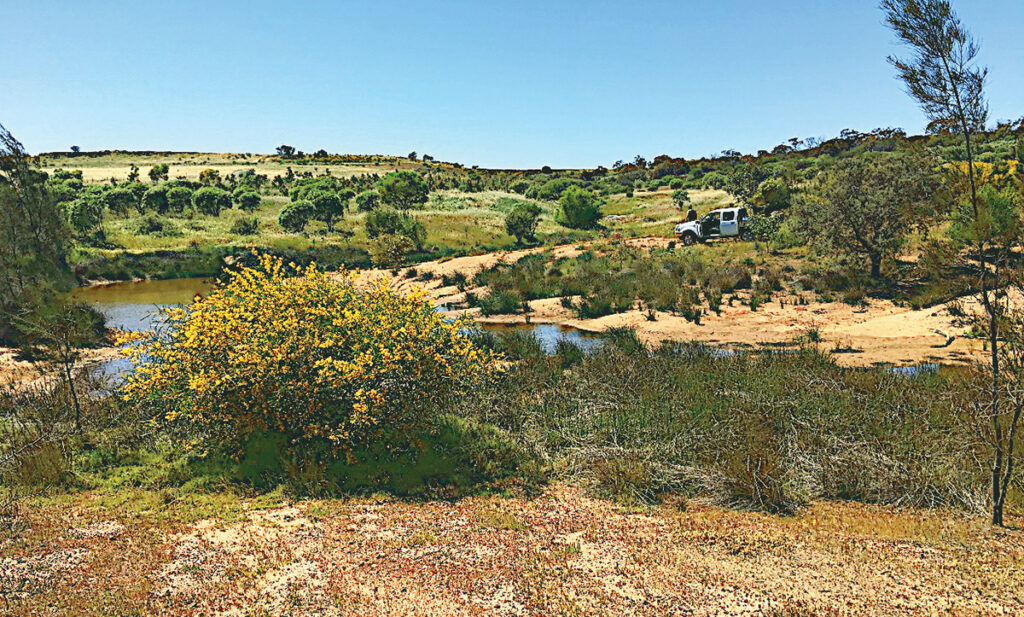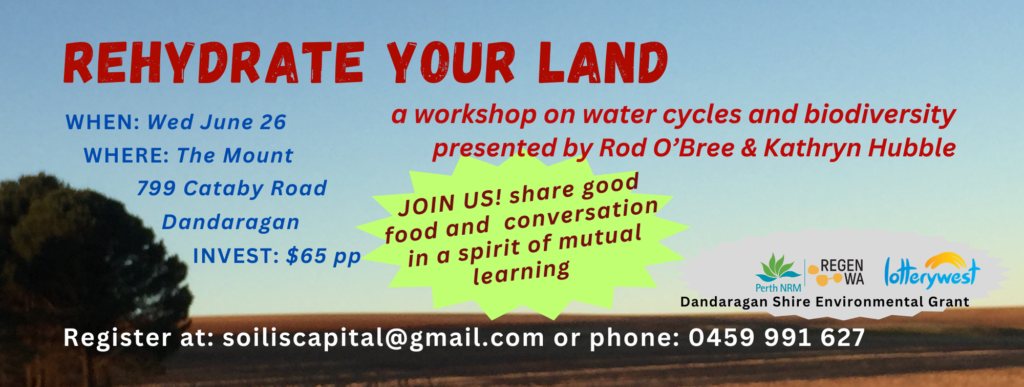Amanda Rowland
In February 2009 in Midwest WA, Rod O’Bree: businessman, horse-lover, would-be-farmer, took a picture of water lying in a barren, hydrophobic landscape on his farm, Yanget, in the Chapman Valley, east of Geraldton. Nine years later, that same view reveals a creek system rich with reeds, grasses, forbs, and trees with water pooling as part of a chain-of-ponds that runs through the property.
These before-and-after images have become a magical talisman for those interested in regenerating agricultural land in the arid zones of WA. You can call it data, but it looks like life; proof positive that arid land can be regenerated by a whole-of-landscape approach to restoring water systems. And Rod is living proof that it can be done while running a business, working with grazing animals on the property, and facing financial hardship brought on by debt and the stresses of running both a farm and a food distribution business.
Yanget Farm
O’Bree family bought Yanget farm in 2008. It covers what historically used to be some of the most desirable grazing/cropping land near Geraldton, an area rich with springs and creeks that was quickly colonised by settlers in the 1850’s. By the time Rod got there the grandeur was somewhat faded, the land’s rolling hills bare, and the creeks deeply gouged by rain. Crops were raised as the result of intense applications of chemical weedkillers, pesticides, and fertilisers.
The word Yanget is derived from the local Aboriginal word for bulrushes. The presence of this water-loving plant gives a clue to the fertility and richness that the land possessed pre-settlement. The old people would set fire to big stands of yanget when the rains started – the idea being you could get a feed from the critters flushed out from the dense stalks, and have a free run at the roots, thick corms that were pounded to make a nutritious carbohydrate that gave the mob energy for the coming cold months.
The Problem
Soon after taking over the farm, Rod watched a big rain event sweep precious topsoil and sediment off the property down deeply eroded creek beds towards Champion Bay. A day later none of this water remained on his farm. This was a turning point for Rod and his family; they figured if they were going to keep their beloved horses on healthy, biodiverse pastures, they needed to change the way the landscape was being managed. Soon after, a chance meeting brought hydrologist Peter Andrews to Yanget, and a friendship based on a shared love of horses became a portal to a new way of thinking about land.
The Learning
Rod entered a long period of hands-on learning as he started to see how he could work with nature’s patterns so water would be held in the landscape. He stood in the rain, shovel in hand, observing how water moved over the land: either building, or destroying soil. He learnt where to construct earth and rock interventions to slow down and direct water flow, observing the role weeds and plants play in a natural progression as the soil built up. As the water slowed and sank into the ground, dirt and plant litter settled, allowing early responding seeds to take root. Over time the agricultural district’s dominant weed, star thistles, were joined by other species of prickly pioneers. As the land rehydrated, the weed load diminished season by season, replaced by an explosion of different seedlings that sprung up in response to the stabilising of the land.
The Healing
When the bulrushes started reappearing in the creek, the O’Bree’s work of restoration started to feel like an act of redemption. Yanget farm’s return to ecological balance helped re-sensitize us to the power of natural processes, teaching us that as land heals, so do we.
The Burringurrah Mob
Rod now describes these years of experimentation and learning as a ‘time of 1000 errors.’. He reckons his learning expanded exponentially when he met some of the men from the Burringurrah mob, up near Mt Augustus. During the Covid lockdowns, as part of his food distribution business, he was able to help bring food and water up to the struggling settlement. Three elders came down from the community in the Gascoyne to meet Rod at the farm, and they started to share what they knew about patterns in the land. The reciprocity of this relationship has been a huge learning curve for Rod, giving him a turbo-charged understanding of natural systems and what needs to be done to restore fertility to our arid lands.
Over this time Rod devised effective ways of teaching what he knew, attracting attention from State Government ministers, landowners, scientists, farmers, and those in the carbon project space keen to learn how to replicate the success of the rehydration project.
Rod bought Mick Davies butcher shop in the main street of Geraldton inspired by a big idea. He coined the term Catchment Food, reasoning that this could be a way to allow the public to support local farmers working with regenerative principles, while giving these farmers an alternative outlet for their premium product.


The Mount
In 2020 Christine and Kingsley Smith at The Mount, in Dandaragan, received a grant from the Shire to undertake analysis of the Minyulo Catchment zone, which included the Smith’s farm. Rod worked with Tim Wiley, a Rangeland scientist, to design the placement of earthworks in the landscape to better manage the rainfall flow, and a system of interventions were placed in the land. At the time a workshop and associated open days were held for interested farmers to observe the work being done.
Upcoming Workshop
Now, four years on, we are keen to get Rod back at The Mount to revisit and re-evaluate the system. The date chosen for the workshop, Rehydrate Your Land, is Wednesday June 26, 2024. Currently the season isn’t looking promising, so we are making the day contingent on enough rain having fallen to show the system at work. Kathryn Hubble, our biodiversity and soil educator, will be there with Rod O’Bree to present the last of the series of workshops Farmer Gardener: Pathways to Regeneration.
If you would like to be notified of any change to the workshop date, and to secure your spot – please register with Amanda at: soiliscapital@gmail.com or phone 0459 991 627 (see workshop details below).









